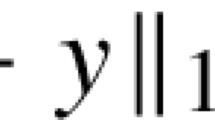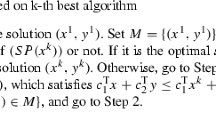Abstract
Bilevel linear optimization problems are the linear optimization problems with two sequential decision steps of the leader and the follower. In this paper, we focus on the ambiguity of coefficients of the follower in his objective function that hinder the leader from exactly calculating the rational response of the follower. Under the assumption that the follower’s possible range of the ambiguous coefficient vector is known as a certain convex polytope, the leader can deduce the possible set of rational responses of the follower. The leader further assumes that the follower’s response is the worst-case scenario to his objective function, and then makes a decision according to the maximin criteria. We thus formulate the bilevel linear optimization problem with ambiguous objective function of the follower as a special kind of three-level programming problem. In our formulation, we show that the optimal solution locates on the extreme point and propose a solution method based on the enumeration of possible rational responses of the follower. A numerical example is used to illustrate our proposed computational method.


Similar content being viewed by others
References
Abass, S. A. (2010). An interval number programming approach for bilevel linear programming problem. International Journal of Management Science and Engineering Management, 5(6), 461–464.
Bard, J. F. (1998). Practical bilevel optimization: Algorithms and applications. Dordrecht: Kluwer Academic Publishers.
Bialas, W. F., & Karwan, M. H. (1982). On two-level optimization. IEEE Transactions on Automatic Control, 27(1), 211–214.
Calvete, H. I., & Galé, C. (2012). Linear bilevel programming with interval coefficients. Journal of Computational and Applied Mathematics, 236(15), 3751–3762.
Cao, M. F., & Huang, G. H. (2011). Scenario-based methods for interval linear programming problems. Journal of Environmental Informatics, 17(2), 65–74.
Dempe, S. (2002). Foundations of bilevel programming. Dordrecht: Kluwer Academic Publishers.
Horst, R., & Tuy, H. (1995). Global optimization: Deterministic approaches, third, revised and enlarged edition. Berlin: Springer.
Inuiguchi, M., & Kume, Y. (1994). Minimax regret in linear programming problems with an interval objective function. In G. H. Tzeng, H. F. Wang, U. P. Wen, & P. L. Yu (Eds.), Multiple criteria decision making (pp. 65–74). New York: Springer.
Inuiguchi, M., & Sakawa, M. (1994). Possible and necessary optimality tests in possibilistic linear programming problems. Fuzzy Sets and Systems, 67(1), 29–46.
Inuiguchi, M., & Sakawa, M. (1996). Possible and necessary efficiency in possibilistic multiobjective linear programming problems and possible efficiency test. Fuzzy Sets and Systems, 78(2), 231–241.
Inuiguchi, M., & Sakawa, M. (1997). Robust optimization under softness in a fuzzy linear programming problem. International Journal of Approximate reasoning, 18(1), 21–34.
Inuiguchi, M. (2004). Enumeration of all possibly optimal vertices with possible optimality degrees in linear programming problems with a possibilistic objective function. Fuzzy Optimization and Decision Making, 3(4), 311–326.
Jiménez, M., Arenas, M., Bilbao, A., & Rodriguez, M. V. (2007). Linear programming with fuzzy parameters: An interactive method resolution. European Journal of Operational Research, 177(3), 1599–1609.
Ren, A., & Wang, Y. (2014). A cutting plane method for bilevel linear programming with interval coefficients. Annals of Operations Research, 233(1), 355–378.
Steuer, R. E. (1986). Multiple criteria optimization: Theory, computation, and application. New York: Wiley.
Wang, J. Z., & Du, G. (2001). Research on the method for interval linear bi-level programming based on partial order on intervals. In Eighth international conference on fuzzy systems and knowledge discovery IEEE (pp. 682–686).
Wang, S., & Huang, G. H. (2013). Interactive fuzzy boundary interval programming for air quality management under uncertainty. Water, Air, & Soil Pollution, 224(5), 1–16.
Wang, S., & Huang, G. H. (2015). A multi-level Taguchi-factorial two-stage stochastic programming approach for characterization of parameter uncertainties and their interactions: An application to water resources management. European Journal of Operatinal Research, 240(2), 572–581.
Author information
Authors and Affiliations
Corresponding author
Rights and permissions
About this article
Cite this article
Inuiguchi, M., Sariddichainunta, P. Bilevel linear programming with ambiguous objective function of the follower. Fuzzy Optim Decis Making 15, 415–434 (2016). https://doi.org/10.1007/s10700-016-9231-2
Published:
Issue Date:
DOI: https://doi.org/10.1007/s10700-016-9231-2




